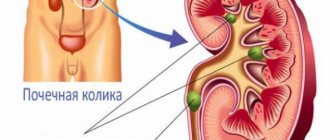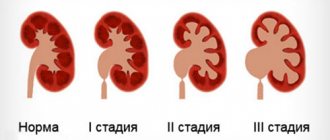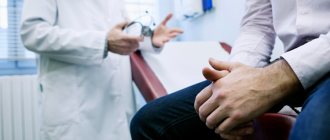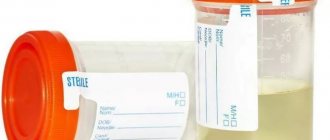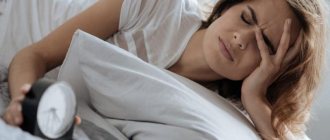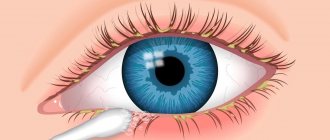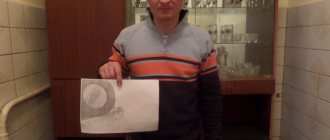Renal calicoectasia (ICD-10 code: Q60) is a deadly pathology; the second name is hydrocalycosis. As this disease progresses, the renal calyx is damaged. The damage is due to the fact that the calyces become overfilled with urine and eventually expand. Hydrocalycosis leads to compression of the kidney tissue. As a result of such problems, the kidneys cannot function normally.
On the right is a healthy kidney, on the left is a kidney with hydrokaliosis
Causes
The main causes of this disease are:
- Urolithiasis, in which stones form in the kidneys and urinary ducts: they interfere with the normal outflow of urine.
- Nephroptosis: in some people, this pathology is associated with the special structure of the ureter.
- Congenital origin. Anomalies in the development of this organ also lead to pathologies, including hydrocalycosis.
- Impaired functioning of the pararenal veins.
- Sometimes pathology occurs against the background of a neoplasm. As you know, the tumor compresses the ureter, and because of this, the outflow of urine is disrupted.
- If pyelonephritis starts, many complications will appear, including hydrocalycosis.
- The cause of the pathology may be trauma to the ureter.
- Scar changes in the ureter are also dangerous to health: hydrocalycosis occurs against the background of this problem.
- Kidney tuberculosis, progression of parasitic infection in the genitourinary system.
Disease in children
Hydrocalycosis of the kidney can occur in a baby who is still in the womb. The doctor detects this in the fetus through abnormalities in the development of the urinary system. To confirm such violations, a screening examination is carried out. In older children it progresses gradually.
How to treat caliectasis of the kidneys
Drug treatment
After the diagnosis is made, treatment is prescribed individually for each patient. The doctor studies the obtained tests and makes a conclusion about what course of treatment will be used.
In the early stages, treatment can be conservative. This therapy involves drug intervention. To cure the pathology, a person will need to use the following remedies:
- Antimicrobials;
- Painkillers (prescribed if the patient’s kidney calyces are significantly dilated, causing severe pain);
- Antibiotics;
- Medicines that stop inflammatory processes.
If a disease is detected in a pregnant woman, treatment methods are reviewed, since some drugs can affect the development of the fetus.
Calicosis can also be treated surgically. It is used in cases where the patient has been diagnosed with malignant tumors, large kidney stones, organ deformation or cysts. The procedure is carried out using one of the following methods:
Strip – used in cases where the patient has contraindications to laparoscopy.
Endoscopic (laparoscopic) - the operation is performed using a puncture on the left side. The procedure is considered the safest for eliminating kidney pathologies.
Folk remedies
The main course of healing, which is aimed at eliminating ectasia, can be supplemented with herbal remedies. The choice of herbs should be discussed with your doctor.
The most effective means are considered:
- St. John's wort;
- Bird knotweed;
- Celery root;
- Ginseng;
- Burdock juice;
- Creeping wheatgrass;
- Rose hip;
- Bearberry;
- Cornflower.
Tinctures are made from herbal remedies, the use and dosage of which should be discussed with a doctor. Compresses are often made from plants, which are applied to the left or right, depending on which organ is affected by the pathology.
Recommended topic:
Anomalies of the development of the genitourinary system
Traditional methods are effective, but their use must be agreed with a doctor.
Diet
To eliminate calicopyeloureterectasia, you will need to give up bad habits
Following a diet will contribute to speedy healing. A patient undergoing treatment for calicopyeloureterectasia will need to avoid the following foods and beverages:
- Eliminate fried and fatty foods from your daily diet;
- If a child is susceptible to the disease, parents should avoid formulas that contain chemicals and preservatives;
- Moderate the amount of salt consumed, as well as pepper and sugar;
- To refuse from bad habits;
- If the pathology was discovered during pregnancy, then the woman needs to increase the amount of fluid consumed to 2 liters daily so that the newborn baby is healthy and strong.
The patient's diet should consist of vegetables, boiled meat or fish, fruits and tonic drinks. The foods you eat should contain as many vitamins and beneficial microelements as possible.
Recommendation! Spend as much time as possible in the fresh air, do light exercise, and drink plenty of fluids to stimulate your genitourinary system.
Compliance with all the rules of the diet will contribute to a speedy recovery, kidney function will return to normal and the patient will be able to continue a normal life without discomfort and back pain.
Symptoms
The main symptoms are:
- chills;
- urine has become dark and cloudy;
- frequent urination, but urine is not completely eliminated;
- there is pain in the lower back. They occur regardless of pressure: with pressure, the unpleasant sensations intensify;
- if the disease progresses, the person’s temperature rises;
- nausea with vomiting appears;
- blood spots in urine.
The symptoms of the pathology in question are similar to gastrointestinal diseases (cholecystitis and appendicitis). A nephrologist treats diseases related to the kidneys.
Treatment
Therapy depends on how severe the hydrocalycosis is. When determining treatment tactics, the doctor takes into account the factors that led to the development of pathology. It is important to say that therapy should be comprehensive:
- Taking medications is aimed at eliminating pain. Additionally, medications are prescribed to help fight the infectious process.
- Painkillers are prescribed.
- If a patient's blood pressure rises, the doctor prescribes special medications. Depending on the nature of the symptoms, antipyretics may be required.
- At the same time, treatment is being carried out for the disease that could lead to caliectasis.
- If it is urolithiasis, medications are prescribed to help dissolve the stones. It is necessary to carry out therapy that will prevent complications.
- Endoscopy may be needed to treat hydrocalycosis. This is a modern treatment method comparable to a full-fledged operation. Surgical intervention is prescribed when taking medications does not lead to the expected result
Signs of the disease
Signs of renal caliectasis can easily be confused with symptoms of other common pathologies, so when the first pronounced symptoms of renal failure appear, you should immediately consult your doctor.
These most pronounced symptoms (signs) are:
- The appearance of pain in the lumbar region (left or right, depending on the spread of the disease).
- An increase in the number of urinations with a decrease in the amount of urine produced.
- Constant nausea, periodically accompanied by vomiting.
- The development of extensive intoxication of the body, accompanied by headaches, chills, elevated body temperature and the appearance of severe weakness and dizziness.
- The appearance of blood in the urine.
The more pronounced the symptoms of the disease, the higher the likelihood that calicoectasia is developed on both sides, regardless of the location of the pain in the lumbar region!
Important! Hydrocalycosis does not occur independently, but appears as an adnexal disease against the background of various factors that impede the normal passage of urine from the kidneys.
Alternative medicine
Along with traditional medicine, you can use folk remedies, for example:
- To prepare an effective medicine, you need to take 50 g of eleutherococcus and ginseng. Plant roots are mixed with 300 ml of vodka. After 3 weeks you will have an infusion: it is taken 1 tbsp. l. once a day.
- To treat kidney-related diseases, rosehip decoction is used. To prepare the medicine, take not the fruits, but the roots of the plant. Grind 50 g of roots and pour 1 liter of boiled water. Determine the product in the dark, wait 12 hours. Then strain the infusion and take 1 tbsp. every 2 hours. The course of treatment is 10 days.
- You need to take blackcurrant leaves and berries. Wash the leaves thoroughly, chop, place in 0.5 liters of boiling water. The infusion is ready in 20 minutes: it is traced and put on fire. You need to boil it for 5 minutes, then put it on the fire and add 50 g of berries. Wait 10 minutes, then take 100 ml 4 times a day.
Diet
For this disease it is usually recommended:
- Baked and steamed vegetables (potatoes, carrots, beets, onions).
- Pumpkin porridge cooked with milk is very healthy.
- It is worth saying that eating raw cabbage leads to gas formation in the intestines: this product should be abandoned. The same goes for apples, but these fruits are not prohibited when baked.
- Rosehip decoction is ideal as a drink.
- Chamomile tea.
In conclusion, we note that treatment in the early stages gives good results.
Treatment of the disease
Depending on the results obtained during a comprehensive diagnosis, treatment may be conservative or require surgical intervention.
Regardless of the location and presence of complications, surgical treatment is preferable and most effective.
When carrying out conservative treatment, the patient is prescribed drugs that eliminate the root cause of the disease, painkillers and antibiotics.
Surgery can be performed in one of the following ways:
- Endoscopy. In this case, the operation is performed without an incision. Surgical intervention takes place within one, or less often two, punctures.
- Strip. This operation is used in the presence of contraindications to endoscopy, as well as in the presence of tumors located at a considerable distance from each other.
An important stage in treating the disease is following a diet and avoiding certain foods, such as:
- Salty and fatty foods.
- Alcoholic drinks and carbonated drinks with a large number of additives and colorings.
- Hot and spicy foods, smoked meats and marinades.
In severe cases of the disease, a more strict diet may be prescribed with a strict caloric restriction (3500 kcal) due to an increase in carbohydrates and proteins, and the complete exclusion of fats.
In the absence of contraindications, treatment can be supplemented by the use of medicinal plants, such as:
- Burdock.
- Bearberry.
- Rose hip.
- St. John's wort.
- Other plants.
How to cure mastitis in women with folk remedies, and is it worth self-medicating?
The following publication will reveal the signs and causes of uterine endometriosis.
About the symptoms and treatment of parametritis: https://venerolog-ginekolog.ru/gynecology/diseases/parametrit-ego-priznaki-kak-lechit.html.
Complications
Calicoectasia of the kidneys can lead to dangerous complications; therefore, the disease must be treated in a timely manner. Therapy in advanced stages is ineffective.
Complications may arise due to the addition of a bacterial infection. If this infection progresses through the urinary ducts, it can be fatal. A complication may be shrinkage of the kidney and loss of functionality of the organ. As the disease progresses, the parenchyma is replaced by connective tissue. The prognosis of the disease is favorable in case of successful treatment. If your doctor recommends abdominal surgery, you should not delay it.
You can also familiarize yourself with the main symptoms of kidney disease in this video.
